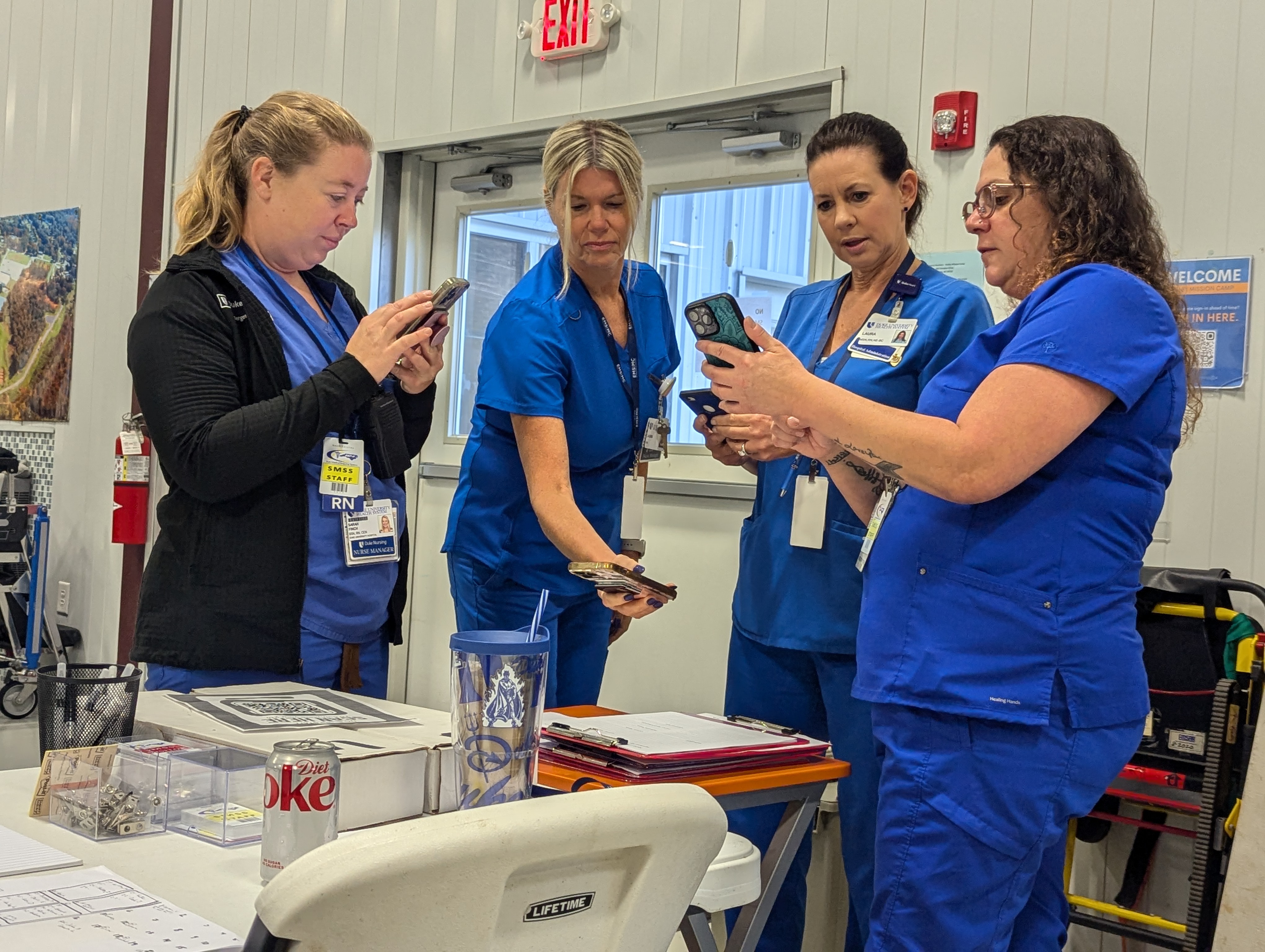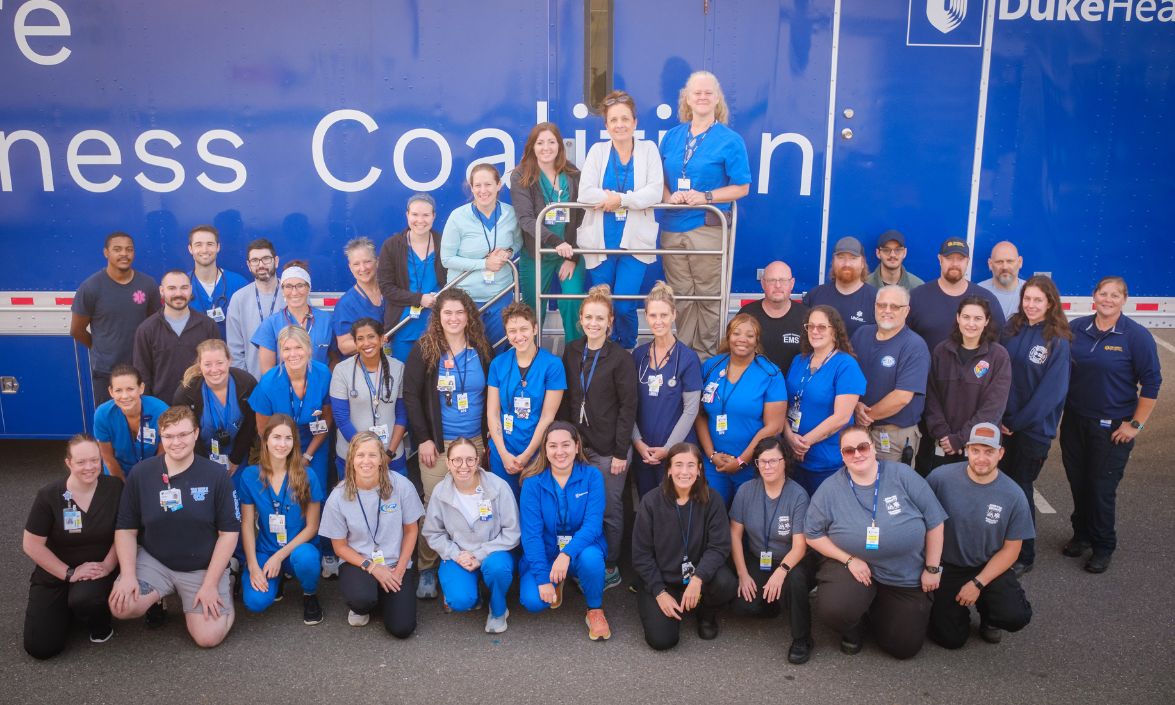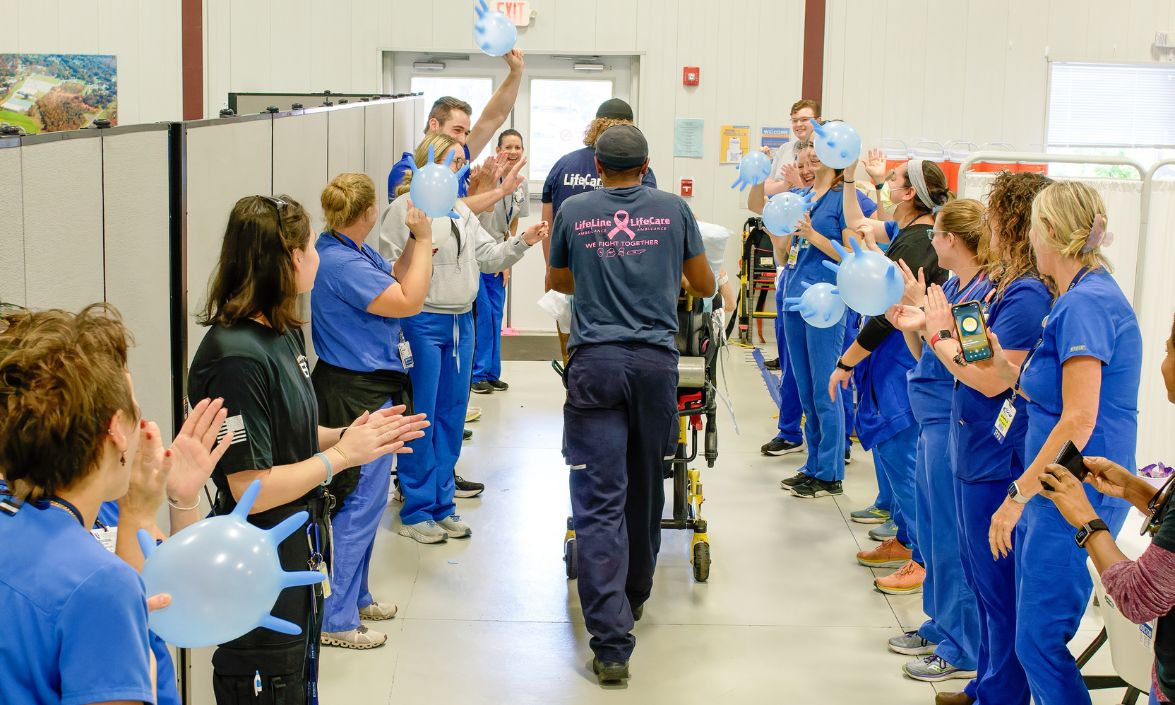Across western North Carolina, the final days of September 2024 will be remembered for the devastation unleashed by Hurricane Helene. Some areas received more than 26 inches of rain in 24 hours and flooding decimated entire towns across 27 counties.
Almost immediately, North Carolina State Medical Assistance Team (SMAT) members deployed to western North Carolina to assess available resources and provide patient care.
Timothy Smith was a patient of the medical shelter set up in Shelby, N.C., by the team.
"I lost everything I ever had, except my life," said Smith, who was living south of Asheville. "The care I received at the emergency shelter was absolutely over the top. It's going to be a slow recovery and hard trying to start over from nothing, but I'm going to do the best I can. Because of the care I received, I already have a really good start. The Duke team saved my life."
A three-week operation
SMAT is a group of medical and non-medical volunteers from various hospitals, EMS agencies, and other medical care entities that report to mobile medical care locations in response to disasters. In response to Helene, the North Carolina team deployed 128 personnel to various locations in Western North Carolina during a three-week operation.
Of those, 103 were Duke employees across multiple locations and departments, and 19 were from outside agencies. The team helped with relief efforts at the Shelby shelter or one of two nearby Duke Lifepoint hospitals.
Most of the SMAT volunteers were focused on medical operations at the shelter, setting up spaces for patient care, pharmacy, team workstations and more. Their work included patient screening and intake, medication pickup and administration, and transportation to critical medical appointments, such as dialysis.
Far from routine medical situations
Hurricane relief volunteers encountered situations that were far from routine. Facilities for eating, sleeping and showering were shared with people they had never met. In some cases, they created makeshift medical supplies due to the lack of items.
In every patient encounter, the team cared for people at their most vulnerable - not only dealing with medical issues but also with the loss of almost everything related to life as they knew it. Most were without utilities; many lost their homes, and some lost loved ones to Helene.
Reflections from Volunteers
Ann Creech, nurse case manager, thoracic surgery, Duke University Hospital
"I greatly appreciate the support for me to be able to come here and do this work. It's been good for my heart, I have made incredible connections with this team, and I would do it all again in a heartbeat."
Laura Fick, clinical nurse, ambulatory care, Duke Regional Hospital
"This is the most rewarding nursing I have ever been a part of. … I have a home in Western Carolina myself that had severe property damage. It was a hard week, but I was grateful to do my part."
Shannon Richardson, clinical nurse, cardiothoracic surgery, Duke University Hospital
"It's a privilege to have supported individuals during their most vulnerable moments. I have witnessed resilience and hope amid adversity. There were moments of sorrow for what the community had endured, but also moments of joy and gratitude as we provided comfort and support. It was an experience that I will carry with me for the rest of my life."
The experience was just as meaningful for the caregivers. For clinical and non-clinical team members alike, the time they spent providing care, while brief, left a lasting impression.


State Medical Assistance Team: Logistics
The State Medical Assistance Team (SMAT) includes seven regional coalitions dedicated to healthcare preparedness response - logistics, communications and medical - with Duke a part of the Central Carolina coalition. The next training for team volunteers is Jan. 18.
The behind-the-scenes work to get the coalition up and running requires dedication and long hours, said Dr. Erin R. Hanlin, Duke assistant professor of emergency medicine, referring to the efforts of healthcare preparedness coordinators David Marsee, Scott Horner and Jon Webster. "(They coordinate) all of those hundreds of volunteers, scheduling them, communicating with them prior to their deployments, and managing all the HR paperwork," said Hanlin.
"The fact of the matter is, they do this kind of work every day, not just during disasters. They are constantly planning, training, managing equipment, all in preparation for the next disaster," Hanlin added.
The Jan. 18 training will focus on the Incident Command System, a nationwide approach to response and recovery for everything from small events, such as festivals, to complex events, such as disasters. The instruction is geared toward operating a variety of clinical equipment, including how to set up large tents and medical cots, as well as how to work inside the team's mobile medical unit.
To become a volunteer, fill out this online form , and affiliate with the Duke Regional Advisory Committee SMAT II. You will be contacted by a member of the NC400 SMAT who will provide you with further information.

More Reflections from Volunteers
Marjorie Huffman, clinical nurse, emergency department, Duke Raleigh Hospital
"I saw a group of people from different entities all working together to set up and run the medical shelter. It was hard to be away from home, sleeping in a trailer with strangers. But we became more than coworkers; we became friends."
Paige Brumett, clinical nurse, pediatric cardiac intensive care unit, Duke Children's Hospital
"Helene took a lot from a lot of people, but it absolutely did not take their kindness and resilience. I have had the honor and privilege of meeting and caring for some of the most wonderful humans I've ever met in my entire life. This Duke team is incredible!"
John Lohnes, physician assistant, orthopedic surgery, Duke University Hospital
I was struck by the resourcefulness and cooperation of not only the volunteers who mobilized to provide aid, but also the resilience and strength of the people who we cared for. It is ironic how disasters like this can bring out the best in people by fostering a sense of community and prompting acts of altruism that we often miss in our day-to-day lives.
"It's a privilege to have supported individuals during their most vulnerable moments. I have witnessed resilience and hope amid adversity."
Shannon Richardson, Clinical Nurse, Duke University Hospital






